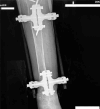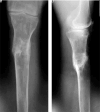The use of regenerative technologies for treatment of delayed fracture union in patient with menopausal osteoporosis
- PMID: 40777870
- PMCID: PMC12327223
- DOI: 10.5114/pm.2025.152148
The use of regenerative technologies for treatment of delayed fracture union in patient with menopausal osteoporosis
Abstract
Delayed fracture union is a common complication in orthopedic practice, particularly in patients with osteoporosis. Advances in regenerative medicine, including mesenchymal stem cells (MSCs) within the stromal-vascular fraction, have introduced novel therapeutic approaches to address this challenge. This case describes a patient with postmenopausal osteoporosis and a congenital anomaly of the left lower limb who sustained a proximal tibial fracture with fragment displacement. Osteoporosis therapy was initiated, and the fracture was managed using external fixation and compression. Despite an improvement in bone mineral density over an eight-month period, radiographic assessment revealed no evidence of fracture union. Consequently, local administration of MSCs combined with needling at the fracture site was performed, followed by a series of autologous concentrated plasma (ACP) injections. Within three months, radiographic signs of bone callus formation were observed, ultimately leading to complete fracture union six months after the initiation of regenerative therapy. Although the limited number of cases in our clinic prevents definitive conclusions regarding the primary contributing factor in fracture healing, existing literature suggests that the mobilization of endogenous resources at the fracture site in high concentrations promotes tissue regeneration. This process is further facilitated by physical activity and adjunctive pharmacological treatment. Regenerative therapy integrating MSCs and ACP-derived growth factors represents a promising adjunctive approach for managing fracture complications in patients with systemic osteoporosis. This strategy has the potential to enhance bone healing while potentially delaying or even avoiding the need for more invasive surgical interventions.
Keywords: autologous concentrated plasma; delayed fracture union; menopausal osteoporosis; mesenchymal stem cells; tibia fracture.
Copyright © 2025 Termedia.
Conflict of interest statement
None.
Figures




References
-
- Yaacobi E, Sanchez D, Maniar H, et al. Surgical treatment of osteoporotic fractures: an update on the principles of management. Injury 2017; 48: S34-S40. - PubMed
-
- Von Rüden C, Augat P. Failure of fracture fixation in osteoporotic bone. Injury 2016; 47: S3-S10. - PubMed
-
- Zhang E, Miramini S, Patel M, Richardson M, Ebeling P, Zhang L. The effects of mechanical instability on PDGF mediated inflammatory response at early stage of fracture healing under diabetic condition. Comput Methods Programs Biomed 2023; 229: 107319. - PubMed
-
- Zhang E, Miramini S, Patel M, Richardson M, Ebeling P, Zhang L. Role of TNF-α in early-stage fracture healing under normal and diabetic conditions. Comput Methods Programs Biomed 2022; 213: 106536. - PubMed
Publication types
LinkOut - more resources
Full Text Sources
